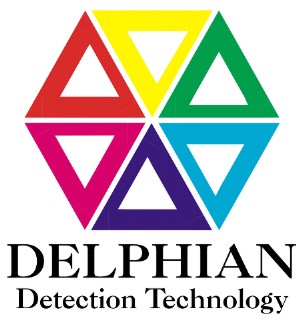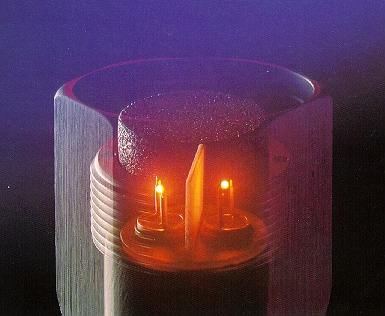|
Delphian's Catalytic Bead Sensor
Delphian’s sensor is a catalytic bead sensor. This sensor is made from
two separate
elements (or beads). One element (the active element) is made by winding a
small coil of wire, sealing it in a ceramic substance and then coating it with a
catalyst. The second element ( the reference element) is made identical to the
active element except in place of the catalyst, a passivating substance is used.
The reference bead compensates for changes in ambient temperature, humidity and
pressure variations. Catalytic bead sensors operate above a threshold or
"turn-on" voltage corresponding to the bead temperature which can, in the
presence of the catalyst and oxygen, first ignite the gas. As the sensor ages,
the catalyst slowly deactivates on the bead. The threshold voltage gradually
increases, and the sensor sensitivity decreases. At the same time, changes in
the wire coil cause increased zero drift and noise. The result is the sensor
must be replaced.
When a mixture of combustible gas or vapor in air diffuses through the sensor
flame arrestor,
it oxidizes on the catalytically treated sensing bead. Since this oxidation
reaction is exothermic, it causes an increase in the temperature of this bead
(in relationship to the temperature of the reference bead) and a resulting
increase in the electrical resistance of a small platinum coil embedded in this
bead. The change in resistance in the embedded platinum coil is proportional to
the amount of chemical energy released by the oxidation reaction. Electronic
circuitry (transmitter) immediately detects this increase in resistance and
reduces electrical power to the bead until the original platinum coil resistance
is restored. The amount of electrical power removed is linearly proportional to
the combustible gas concentration present.
Calibration Gases for Combustible Sensors:
Delphian’s standard calibration gas is 2.5 % methane (50% LEL) for Methane, CNG
(compressed natural gas) and LNG (liquefied natural gas). Delphian’s standard
calibration gas for Propane or LPG (liquefied petroleum gas) is 1.1% Propane
(50% LEL). Other concentrations or calibration gases can be used. Read the label
for verification of calibration gas requirements. Delphian recommends 2.5 %
methane as the calibration gas for all other fuels, including methanol, ethanol
and gasoline. The accuracy tolerance of the concentration of the calibration gas
is + 2% of standard. Therefore, 2.5% methane may indicate an actual
concentration of 2.45 to 2.55%. (See Calibration)
Questions to ask
manufacturers of catalytic sensors
1. How are your sensors powered,
constant voltage, current or temperature?
2. What type of catalyst do you use?
3. What is your sensor’s activation temperature?
4. What type of bead construction do you use?
5. What is your sensor’s signal to noise ratio and how do you measure it?
6. What is your sensor’s response time and define your terms. Any time to 63%
final response when 50% LFL is applied. How is test conducted?
7. What is your sensor’s response to gas flooding?
8. Are dust
covers available?
9. What happens if your sensor is washed with a hose?
10. How do you measure your sensor’s life?
11. What is your average zero drift?
12. Do you offer a sensor with
replaceable elements?
Glossary
of Gas Detection Terms | Part
Numbers
How to specify a Delphian system
The Gas Monitoring Handbook
Copyright ©2025 Delphian Corporation, 220 Pegasus Avenue, Northvale, N.J., U.S.A.
|

